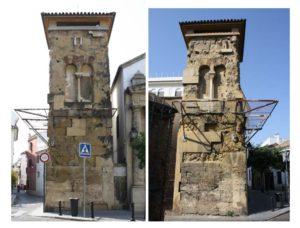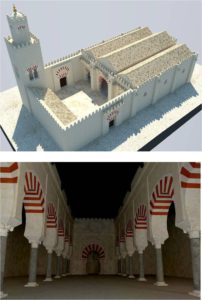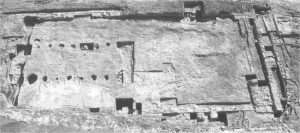
Religion

Religion played a transcendental role in the configuration of the Islamic society, in general, and the Andalusi one, in particular. Specifically, the daily prayer conditioned in large part the ways of life of the community of believers, who found in the mosque their main place for praying and assembling. Sacred building par excellence, the mosque also fulfilled other functions that made it the element that better symbolized and represented the essence of Islam from the first moment. This space also acquired great importance in the organization of the different settlements and was used as a means of legitimizing the power.

Beyond the Great Mosque, and without taking into account the data from written and epigraphic sources, several secondary mosques of Madīnat Qurṭuba have been documented archaeologically. However, the information is quite unequal since some of them barely conserve a few vestiges. At times, the presence of minarets or structures oriented towards the southeast have been enough to interpret some of these buildings. In other cases, mosques were transformed into Christian temples, as it has been proved in the churches of San Lorenzo or San Juan de los Caballeros.

Within the city, one of the most significant secondary mosque was located on Rey Heredia street. The current building (ancient convent of Santa Clara) still preserves the first section of the minaret, the foundations of the whole construction, the courtyard and part of the walls of the prayer room, including the qibla. In the suburban sectors, the mosque excavated in Fontanar de Cábanos is specially remarkable since its total floor area could be documented, despite its advanced state of destruction. The building get inserted in the urban planning that flourished in the western suburb during the Umayyad Caliphate, surrounded by streets, dwellings and other structures.
Bibliography
AA.VV. (1990): Rehabilitación de la iglesia de Santiago de Córdoba, Córdoba.
CABALLERO, L. et alii (2007): Iglesia del ex-Convento de Santa Clara de Córdoba, Madrid.
CALVO, S. (2007): “Las primeras mezquitas de al-Andalus a través de las fuentes árabes (92/711-170/785)”, Al-Qantara nº 28, 143-179.
CALVO, S. (2015): Las mezquitas de al-Andalus, Almería.
CARMONA, S. et alii(2003): “Seguimiento arqueológico del vaciado del sótano de la Estación de Autobuses de Córdoba y de la urbanización de los viales adyacentes”, AAA 2000, III-Urgencias, Sevilla, pp. 268-272.
DE VICENTE, J. I. (2014): La iglesia fernandina de San Lorenzo de Córdoba. Estudio histórico-arqueológico, Trabajo de Fin de Máster, Universidad de Granada.
ESCRIBANO, V. (1964-1965): “La mezquita de la calle Rey Heredia”, al-Mulk nº 4, pp. 83-101.
GOLVIN, L. (1979): Essai Sur l’Arquitecture Religieuse Musulmane, vol. 4, L’Art Hispano-Musulman, Paris.
GONZÁLEZ GUTIÉRREZ, C. (2012): Las mezquitas de barrio de Madinat Qurtuba: una aproximación arqueológica, Córdoba.
GONZÁLEZ GUTIÉRREZ, C. (2015): Las mezquitas de la Córdoba islámica: concepto, tipología y función urbana, Córdoba (Tesis Doctoral).
HERNÁNDEZ GIMÉNEZ, F. (1927-1928): “Alminar de San Juan”, Anales de la Comisión Provincial de Monumentos Históricos y Artísticos de Córdoba, año 1927-1928, pp. 28-32.
JORDANO, M. A., et alii (1997): Iglesias de la Reconquista: itinerarios y puesta en valor, Córdoba.
LÓPEZ GUERRERO, R.; VALDIVIESO, A. (2001): “Las mezquitas de barrio en Córdoba: estado de la cuestión y nuevas líneas de investigación”, AAC nº 12, pp. 215-239.
LUNA, D.; ZAMORANO, A. (1999): “La mezquita de la antigua finca El Fontanar (Córdoba)”, Cuadernos de Madinat al-Zahra nº 4, pp. 145-173.
MAZZOLI-GUINTARD, C. (2005): “Mosquées, territoire et communauté de quartier en al-Andalus: le cas de Cordoue aux Xe-XIe siècles», Iglesias y Fronteras, V Jornadas de Historia en la Abadía (Alcalá la Real, 19-20 de nov. de 2004), F. Toro Ceballos et A. Linage Conde éds., Jaén, 2005, p. 465-480.
PAVÓN, B. (1976): “Alminares cordobeses”, Boletín de la Asociación Española de Orientalistas nº 12, pp. 181-210.
PAVÓN, B. (2009): Tratado de arquitectura hispanomusulmana vol. IV: “Mezquitas”, Madrid.

